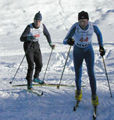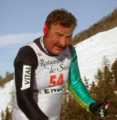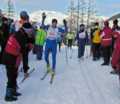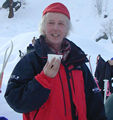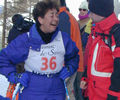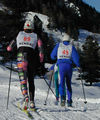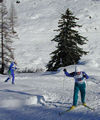|
Story
by Randy H. Milgrom
Photography by Bob Garypie and
Peter Ottlakan
Nendaz
to Siviez
The trip from Nendaz to Siviez, where
the cross-country skiing events are held, is winding and slow.
Most athletes travel by bus, on a road barely wide enough
to accommodate a passing cyclist. Bordered first on one side
and then on the other by a steeply rising mountainside dotted
with tall evergreens and an occasional, lonesome cabin, the
path snakes and trudges upward, switchback by tricky switchback.
As we travel along the rim of the ridges surrounding the
Canton Valais, the small sprawl of Sion, its capital, can
be seen following along the thin line of the Rhone River that
runs through it. Its small airport runways, which hug an odd
parcel of plain land, beckon visitors bold enough to fly over
the snowy peaks and then dive swiftly and safely toward level
ground.
More and more snow gathers as the bus ascends, and only the
prickly tops of evergreen trees are visible – and nothing
more – until the road settles back and eases toward Siviez
– a skiing outpost far smaller than Nendaz, and without the
many local shops and specialty restaurants and hidden night
spots. Here skiing is the thing – the only thing – and the
cross-country course awaits.
Preparing
For the Race
Suspended high and relentlessly wide in an utterly cloudless
sky, the sun hovers above a distant sheet of towering ice-rock
and gently warms the participants readying for the start of
the grueling one-hour race. On a protruding platform just
off the designated course and crowded by the looming mountain
peaks, the 40 or so men and women mill and fidget, speaking
different languages, shaking hands, and raising voices of
greeting or advice. At times, it falls nearly silent – except
for the shushing of skis or the pricking of poles in the snow.
Some competitors wax their skis. Others simply examine them,
as if performing an intricate measurement – or a thoroughgoing
checkup. One man laces and re-laces his colorful ski boots
– red, yellow, purple, green. Another gouges at the undersides
of his skis with a putty knife.
Race officials steady their stopwatches and rifle through
pages of race rosters and course information. A large container
of hot tea and cups are placed on a table near one portion
of the track, which is a long, sloping, looping oval – with
three sets of ski tracks firmly embedded in the hardened snow
from the preceding hour’s course inspection and practice session.
The corner nearest the scorer’s table contains a hairpin turn
– a devil of an uphill climb heading into the home stretch.
As one, the competitors rise and move toward the starting
line as a race official begins a reading of the roll. All
together, they crowd and bunch among all three lanes, and
the faster racers edge closer to the front. Without warning,
a barely audible “Go” is uttered. And the race is on.
A
Test of Endurance
A few at the front take off with a jump. Toward the back,
two men and two women wait for the pile to clear before they
ease into position and start gliding away. The vast middle,
elbowing and grunting and clamoring for space, dig in against
the odds and push forcefully and quickly from the gate.
This race lasts an hour – a lifetime on skis. And as in any
lifetime, there are ups and there are downs. The fastest skiers
fly uphill as if they wear sneakers – nearly popping out of
their bindings onto the balls of their feet and just running!
– while others tend to hustle to the top using forceful little
strides. And then there are those who struggle, who turn sideways
on occasion, and who gain strength from those who cheer.
But the pain of exertion is on everyone’s face. Some rest
on the downhill stretches, while others push ahead. Some lunge
and stab with their poles, while others just lengthen their
strides.
In less than one full lap around, the pack has thinned considerably.
One or two are way out in front, and then a series of groups
of five, and then four, and then three, soon follow. By the
time the slowest skier passes the start line for the first
time, the leader, and eventual winner, has done so twice.
And so it goes. It’s a test of endurance. May as well enjoy
the ride.
"You must just keep going," shrugs a smiling Ursula McGouran,
wife of Peter McGouran, who since his sudden need for a kidney
transplant in 1992 has competed in all four Winter World Transplant
Games, and every annually held British event as well.
There's Peter now, smilimg and almost waving as he passes.
"Same split time as last lap," she encourages. And he just
keeps on skiing on.
|

